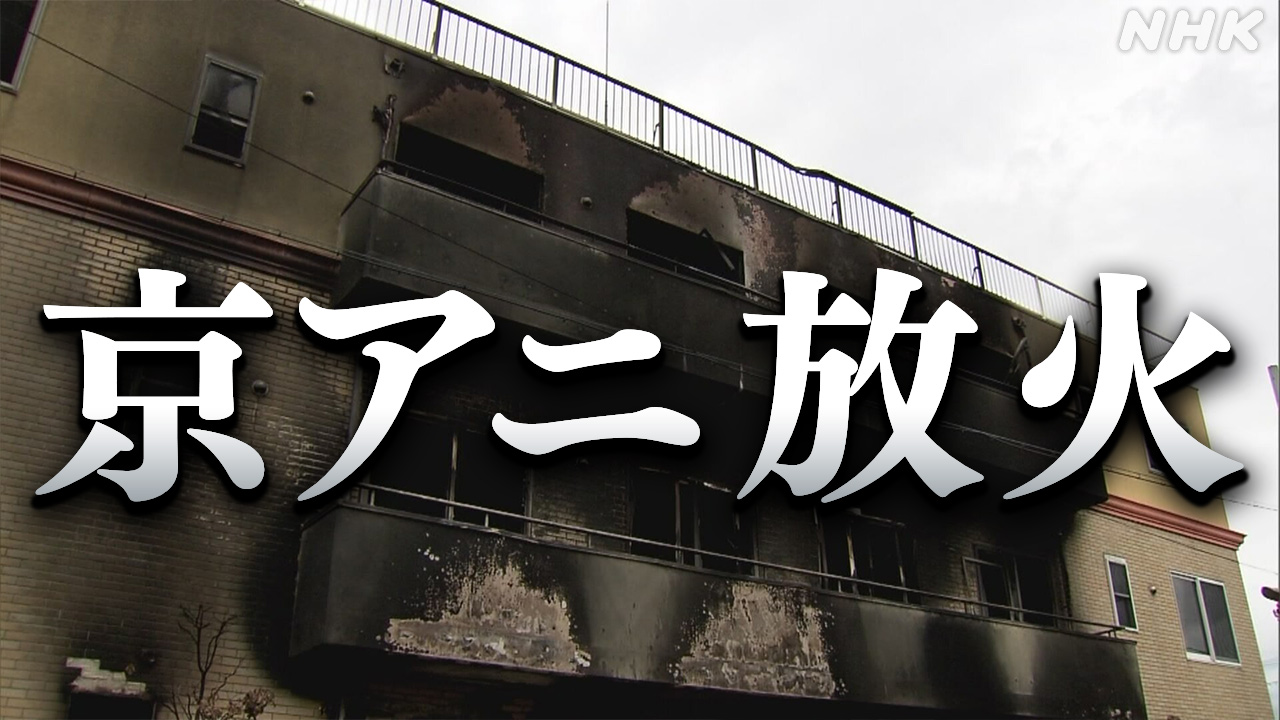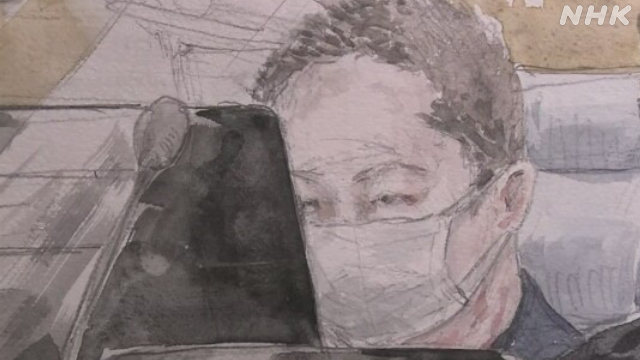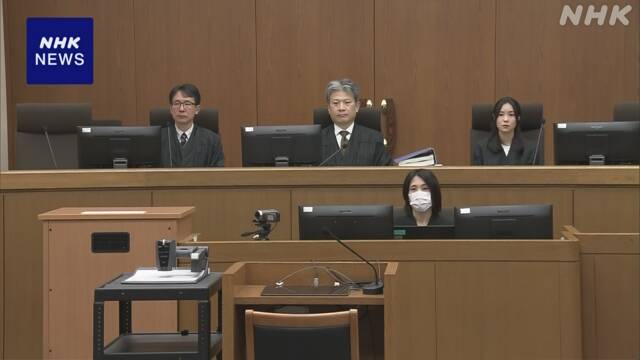KYOTO, Jan 25 (News On Japan) - On March 25th, The Kyoto District Court is set to deliver its verdict for Shinji Aoba, the defendant accused of murder and arson in the case of the deadly arson attack on Kyoto Animation's studio five years ago.

The attack resulted in the deaths of 36 employees and serious injuries to 32 others. The prosecution has demanded the death penalty, while the defense has argued for acquittal due to the defendant's alleged mental incompetence. The focus is on how the court will judge Aoba's mental state and the severity of his punishment.
Shinji Aoba (45) is accused of setting fire to Kyoto Animation's Studio 1 in Fushimi Ward, Kyoto City, in July 2019, killing 36 employees and injuring 32 others. The lay judge trial for this incident, which resulted in the highest number of victims in a murder case in Japan since the Heisei era, has been conducted over 22 sessions since September last year. The key issue has been whether Aoba had the capacity to be held criminally responsible for his actions at the time of the incident.
The prosecution argued that although Aoba's motive was influenced by delusions that Kyoto Animation had stolen his work, the impact was limited. They contended that Aoba had full criminal responsibility and sought the death penalty. On the other hand, the defense claimed that Aoba was living in a delusional world and committed the attack while engulfed in his delusions, leading them to argue that he had no criminal responsibility due to severe mental illness.
The verdict will be delivered at the Kyoto District Court from 10:30 AM on the 25th, with the court's judgment on Aoba's criminal responsibility and the severity of his sentence being the focal point.
The Main Issue of the Trial: Aoba admitted to the charges he was accused of, leaving no significant dispute over the facts. The main issue was whether he had the capacity to be held criminally responsible at the time of the incident, with conflicting arguments presented by the prosecution and the defense.
Prosecution's Argument: The prosecution acknowledged that Aoba might have delusional personality disorder, but claimed the influence was limited. They argued, "While he had delusions, the crime was not committed under their domination but was rather due to his personality, which includes attacking out of accumulated frustration. It cannot be said that his capacity for responsibility was significantly diminished." They also stated that Aoba knew that arson and murder were serious crimes and was capable of refraining from committing them, demonstrating consistent decision-making unaffected by delusions. Two psychiatrists who conducted mental evaluations agreed that Aoba could understand that his actions constituted a crime, leading the prosecution to insist that he had full criminal responsibility. They further argued for the death penalty, stating, "The defendant harbored an unreasonable grudge against Kyoto Animation and caused an exceptionally high number of victims in the history of Japanese criminal trials. The suffering and sorrow of the bereaved families and victims are profound, and the desire for punishment is intense."
Defense's Argument: Conversely, the defense lawyers claimed that Aoba had a severe delusional disorder and lacked criminal responsibility. They criticized the psychiatric evaluation ordered by the prosecution for omitting Aoba's delusion of being controlled by a "Number 2" figure from a "dark organization" that dominated his mental world and reality. They highlighted the significance of Aoba canceling his smartphone subscription four months before the incident, interpreting it as a result of his belief that he was being manipulated by "Number 2," with the internet being his main connection to the outside world. The defense argued that Aoba had been tormented in an uncorrectable delusional world for over ten years and lacked the capacity to realize and refrain from his actions. They sought either an acquittal on the grounds of insanity or a lighter sentence due to diminished capacity.
The Bereaved Families Before the Verdict: Yasuhiro Takemoto's mother, Chieko Takemoto (75), whose son was a popular director at Kyoto Animation and died at age 47, expressed her concerns before the verdict. "The trial revealed that the underlying claim was 'theft of a novel,' which makes me doubt whether there is truly any remorse. I wonder if the defendant will accept the verdict if it's harsh, considering he has a sense of being a victim of 'theft.' Regardless of the verdict, I hope this will be the end," she said. Chieko, who had not been able to attend the trial, planned to observe the final judgment in person, saying, "I want to see it through for my son at least this last time."
Naomi Ishida's mother, who lost her daughter (then 49), a color designer and animator at Kyoto Animation, stated, "I didn't have any particular feelings about the defendant before, but as the trial began, I became increasingly frustrated by his repeated claims that the reason for the incident was his upbringing or Kyoto Animation's fault. No matter how severe the verdict, my daughter won't come back, and it feels empty." Naomi's father had expressed a desire to confront the defendant in court, but he passed away from illness just before the trial began. Her mother said, "I will check the news at home for the verdict. Regardless of the outcome, I will report it to them at the altar."
The father of a male animator who died said he had attended the trial twice but felt no sense of atonement from Aoba. In court, the father's statement was read, "We hope that this trial will serve as a deterrent to prevent cruel crimes like this that cause families to lose sons, daughters, husbands, wives, and children their parents." The father decided not to attend the crowded verdict session, expressing, "Our frustration, sadness, and loneliness as bereaved families will never heal. The 36 lives lost cannot receive any compensation from the defendant, but we had hoped for an apology during the trial. Regardless of the verdict, we want society to reflect on this tragic incident so that nothing like it happens again."
The Five Charges Against Defendant Aoba: In the current trial, Aoba faces five charges, including murder and arson.

1. Trespassing: On July 18, 2019, around 10:30 AM, he is accused of trespassing into Kyoto Animation's Studio 1 through the main entrance. 2. Arson: He then allegedly doused employees with gasoline from a bucket on the first-floor central area and ignited it with a lighter, causing the studio with 70 employees to burn down. 3. Murder and 4. Attempted Murder: He is charged with murdering 36 people and injuring 32 others. 5. Violation of the Firearms and Swords Law: Additionally, he is accused of carrying six knives without a valid reason on the day of the incident.
New Facts and Circumstances Revealed in the Trial: The trial has uncovered new facts and detailed circumstances of the incident through evidence examination and questioning of the defendant.
1. Planned Terror in Omiya: In the prosecution's opening statement, it was revealed that Aoba had gone to the area in front of Omiya Station in Saitama Prefecture a month before the incident, intending to commit indiscriminate murder but ultimately abandoned the plan. Aoba stated during questioning, "I wanted to convey to Kyoto Animation that stealing novel ideas led to such an outcome. I decided not to proceed because the crowd density was low and it wouldn't result in a significant incident."
2. Referencing Past Incidents: Regarding the planning of the incident, Aoba disclosed during questioning that he referred to past events where people died after gasoline was spread in a consumer finance office and a mahjong parlor arson. He also mentioned that he had decided to go as far as those incidents in the final stages. When asked why he brought six knives to the scene, he referred to an indiscriminate killing incident in Tokyo's Akihabara where pedestrians were run over and stabbed, resulting in seven deaths, saying, "I anticipated being stopped after spreading the gasoline."
3. Testimonies from Employees: During witness questioning, two employees who witnessed Aoba igniting the fire inside the building testified about the situation. One employee said, "The defendant forcefully doused my head and body with a liquid that smelled like fuel. Then, he set it on fire while loudly saying 'Die.' The flames reached the ceiling, and I escaped to the bathroom." Another employee testified, "The defendant was shouting short phrases. The room became so bright it turned white, and I was hit by the smell of gasoline and a blast of hot air."
Defendant Aoba's Claims in Court: During the trial, Aoba admitted to "going too far" and expressed apologies to the bereaved families and victims. However, he consistently claimed that Kyoto Animation had stolen his novel ideas. When asked by the presiding judge if there were any errors in the charges, Aoba responded, "There are none. At that time, I thought it was the only thing I could do. I did not expect so many people to die; it was excessive."
In response to questions about how he perceived the rejection of his novel submitted to Kyoto Animation, Aoba stated, "I was disappointed and felt betrayed. I thought that a person called 'Number 2' was responsible for the rejection, as they didn't want me to have a say, and as a result, a considerable amount of money flowed to Kyoto Animation." He also claimed that although he had not included all of his ideas in the submitted work, parts of it had leaked online and were stolen. Kyoto Animation's president testified in court, "We are not a company that can steal ideas from others. It's heartbreaking that the incident occurred based on the defendant's misconceptions," denying any plagiarism. Aoba reiterated his claim, saying, "A director from Kyoto Animation mentioned my ideas on a blog, so it's impossible that they didn't read my work." When asked if it was necessary to involve even those who were doing clerical work in the studio, Aoba said, "Anime production is not completed by one person, so I think a few people created the plagiarized scenes. If those who were unaware of the plagiarism had asked those who knew and then submitted their resignation, they could have avoided becoming victims."
In the final questioning session on December 6, when asked by the prosecutor what he meant by "going too far," Aoba answered, "I mean it includes a feeling of remorse, and I do feel very sorry," apologizing to the bereaved families and victims for the first time. When asked how he received the victim impact statements wishing for the death penalty, he said, "There is a part of me that thinks I should atone in that way." However, regarding his claim of Kyoto Animation stealing his novel ideas, he insisted, "I believe that Kyoto Animation did what they did. Although the psychiatric evaluators mentioned it was a delusion, I consider it a fact." He also mentioned during questioning by the defense that he was being supported by the staff at the detention center, saying, "If I had been brought to Osaka Detention Center earlier and placed in such an environment, I probably wouldn't have committed the incident."
Progress of the Trial: The trial began in September last year and consisted of 22 sessions, concluding on December 7.

September 5, 2023 - First Trial: In the first trial, Aoba acknowledged the charges, stating, "At that time, I thought it was the only thing I could do, but I did not expect so many people to die; it was excessive."
September 6-7 - Evidence Examination: In the second trial, audio data of Aoba shouting "My novel was stolen" when he was apprehended was played. Additionally, a comparison between Kyoto Animation's works and the novel Aoba claimed to have written was conducted, revealing that Aoba had confessed to having similar descriptions in his novel for three scenes depicted in the anime.
September 7-25 - Defendant Questioning: From the third trial, defendant questioning took place. Aoba explained the reason for submitting his novel, stating that he couldn't continue working after his criminal past was discovered at his workplace, and he decided to devote himself to writing to make a living. However, the shock of his submission being rejected after spending over seven years writing it was significant, leading him to burn his notebook of novel ideas and stating, "The barrier that prevented me from committing a crime was gone, and I headed towards doing something wrong." He also mentioned hesitating before the act, saying, "Even a villain like me has a conscience, and I knew it was wrong."
September 27 - October 11 - Witness Questioning: From the tenth trial, witness questioning occurred, with employees testifying about witnessing Aoba setting the fire. Kyoto Animation's president Hatta also testified, countering Aoba's claim of idea theft by stating, "We are not a company that can steal ideas from others."
October 23-30 - Deliberation on Criminal Responsibility: From the thirteenth trial, intensive deliberation on Aoba's criminal responsibility took place. Two psychiatrists who conducted mental evaluations testified, presenting different views. The psychiatrist who evaluated Aoba before the indictment at the prosecution's request stated, "After developing the delusion that Kyoto Animation plagiarized his novel, Aoba did not take realistic actions such as directly protesting, and the delusion did not significantly affect his behavior." In contrast, the psychiatrist who evaluated him after the indictment at the defense's request said, "Aoba had a history of quitting jobs when problems arose. He delusionally believed that Kyoto Animation 'continued to plagiarize,' and he committed the crime to sever ties with them," indicating that the delusion influenced the act.
November 6 - Intermediate Statement & Intermediate Argument: During the sixteenth trial, the prosecution and defense presented their intermediate statements and arguments regarding criminal responsibility. The lay judges and judges then conducted a private intermediate deliberation.
November 27 - December 6 - Deliberation on Circumstances: From the seventeenth trial, deliberation on the circumstances affecting the severity of the sentence took place, with bereaved families and victims expressing their feelings directly. One family member pleaded, "Please return my daughter. I wish I could have died with her. I wanted to be by her side, as she was so dependent." Another family member recounted singing a lullaby to their deceased daughter and sang the lullaby in court, strongly demanding the death penalty for Aoba.
During the twenty-first trial, the final questioning of the defendant took place. When directly asked by a family member how he felt about the bereaved families and victims, Aoba replied, "I am sorry," apologizing for the first time in the trial.
December 7 - Final Statement, Final Argument & Conclusion: In the twenty-second trial, the prosecution demanded the death penalty, while the defense reiterated their plea for acquittal, concluding all proceedings.
"Victim Participation System" Allows Bereaved Families to Question: In this trial, the identities of the 36 killed and all 32 injured were kept confidential, with their names not read aloud in court but indicated by numbers on a list of victims. The bereaved families and victims used the "Victim Participation System" to sit in the gallery or the prosecution's seats, directly questioning Aoba and expressing their feelings.
Deliberation in the Lay Judge Trial: In this trial, six lay judges and six substitute lay judges were appointed, participating in 22 sessions of deliberation from the first trial on September 5 to the conclusion on December 7. The deliberations of the lay judge trial were conducted in private, with six lay judges and three judges deliberating on whether the defendant was guilty or not, and if guilty, the severity of the sentence. The trial, which lasted over four months, had two rounds of deliberations to organize the issues, with the intermediate deliberation in November concluding on Aoba's criminal responsibility, the results of which will be revealed in the verdict. The final deliberation after the conclusion discussed the severity of the sentence. Each judge and lay judge has one vote, and decisions are typically made by majority vote. However, if opinions are divided and a heavier sentence is considered for the defendant, it cannot be concluded even if more than five lay judges agree; at least one judge must concur.
Employees Yet to Return to Work: At the time of the incident, Kyoto Animation had 176 employees, with 70 involved in the incident at Studio 1. According to the company, recruitment was temporarily suspended due to the incident but has resumed, with the current number of employees at approximately 170, nearly the same as before the event. Some injured employees have returned to work after treatment, but others are still recovering and have not been able to return.
The Site of Studio 1: The site of Kyoto Animation's Studio 1, where the incident occurred, has been left vacant since the building was demolished. The company plans to keep the site private, with the potential for a memorial monument in the future or use as company business land. Additionally, the company, bereaved families, and others are considering installing a monument in Uji City, Kyoto Prefecture, where the company's headquarters is located, as a symbol to remember the incident, the victims, and the extensive support received. A committee including bereaved families and employees decided last December to place the monument in a park near a station in Uji City, aiming to complete it by July this year, marking five years since the incident.
Source: NHK


 by
by 










